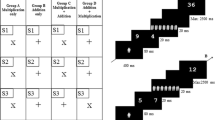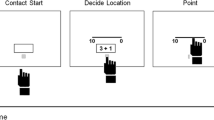Abstract
In three experiments, we tested the hypothesis that activation of multiplication operand nodes (e.g., 3 and 8) can occur through presentation of their product (e.g., 24). In Experiments 1 and 2 we found activation of the operands when the product was presented as a cue in a number-matching task. In Experiment 3, activation also occurred in a parity-matching task, where the product (24) was not relevant to the parity matching on its operands (3 and 8). We concluded that bidirectional links exist among the operands and their product for multiplication problems and these links can be activated in a purely stimulus-driven manner. We suggest this may constitute the basis for the solution of simple divisions by mediation through the complementary multiplication facts.





Similar content being viewed by others
References
Amassian, V. E., Maccabee, P. J., Cracco, R. Q., Cracco, J. B., Rudell, A. P., & Eberle, L. (1993). Measurement of information processing delays in human visual cortex with repetitive magnetic coil stimulation. Brain Research, 605, 317–321.
Ashcraft, M. H. (1987). Children’s knowledge of simple arithmetic: A developmental model and simulation. In J. Bisanz, C. J. Brainerd, & R. Kail (Eds.), Formal methods in developmental psychology: Progress in cognitive development research (pp. 302–338). New York Berlin Heidelberg: Springer.
Ashcraft, M. H. (1992). Cognitive arithmetic: A review of data and theory. Cognition, 44, 75–106.
Baroody, A. J. (1983). The development of procedural knowledge: An alternative explanation of chronometric trends of mental arithmetic. Developmental Review, 3, 225–230.
Campbell, J. I. D. (1987). Production, verification, and priming of multiplication facts. Memory and Cognition, 15, 349–364.
Campbell, J. I. D. (1994). Architectures for numerical cognition. Cognition, 53, 1–44.
Campbell, J. I. D. (1995). Mechanisms of simple addition and multiplication: A modified network-interference theory and simulation. Mathematical Cognition, 1, 121–164.
Campbell, J. I. D. (1999). Division by multiplication. Memory and Cognition, 27, 791–802.
Campbell, J. I. D., & Xue, Q. L. (2001). Cognitive arithmetic across cultures. Journal of Experimental Psychology: General, 130, 299–315.
Cipolotti, L., & de Lacy Costello, A. (1995). Selective impairment for simple division. Cortex, 31, 433–449.
Dehaene, S., Piazza, M., Pinel, P., & Cohen, L. (2003). Three parietal circuits for number processing. Cognitive Neuropsychology, 20, 487–506.
Fuentes, L. J., & Humphreys, G. W. (1996). On the processing of “extinguished” stimuli in unilateral visual neglect: An approach using negative priming. Cognitive Neuropsychology, 13, 111–136.
Galfano, G., Rusconi, E., & Umiltà, C. (2003). Automatic activation of multiplication facts: Evidence from the nodes adjacent to the product. Quarterly Journal of Experimental Psychology, 56A, 31–61.
Graham D. J., & Campbell, J. I. D. (1992). Network interference and number-fact retrieval: Evidence from children’s alphaplication. Canadian Journal of Psychology, 46, 65–91.
Hittmair-Delazer, M., Semenza, C., & Denes, G. (1994). Concepts and facts in calculation. Brain, 117, 715–728.
Hupe, J. M., James, A. C., Girard, P., Lomber, S. G., Payne, B. R., & Bullier, J. (2001). Feedback connections act on the early part of responses in monkey visual cortex. Journal of Neurophysiology, 85, 134–145.
Kiger, J. & Glass, A. (1983). The facilitation of lexical decision by a prime occurring after the target. Memory and Cognition, 11, 356–365.
Krueger, L. E. (1986). Why 2×2=5 looks so wrong: On the odd-even rule in product verification. Memory and Cognition, 14, 171–180.
LeFevre, J.-A., & Morris, J. (1999). More on the relation between division and multiplication in simple arithmetic: Evidence for mediation of division solutions via multiplication. Memory and Cognition, 27, 803–812.
LeFevre, J.-A., Bisanz, J., & Mrkonjic, L. (1988). Cognitive arithmetic: Evidence for obligatory activation of arithmetic facts. Memory and Cognition, 16, 45–53.
Lemaire, P., & Fayol, M. (1995). When plausibility judgments supersede fact retrieval: The example of the odd-even effect on product verification. Memory and Cognition, 23, 34–48.
Mauro, D. G., LeFevre, J.-A., & Morris, J. (2003). Effects of problem format on division and multiplication performance: Division facts are mediated via multiplication-based representations. Journal of Experimental Psychology: Learning, Memory and Cognition, 29, 163–170.
McCloskey, M. (1992). Cognitive mechanisms in numerical processing: Evidence from acquired dyscalculia. Cognition, 44, 107–157.
Meagher, P. D., & Campbell, J. I. D. (1995). Effects of prime type and delay on multiplication priming: Evidence for a dual-process model. Quarterly Journal of Experimental Psychology, 48A, 801–821.
Mulligan, J. T., & Mitchelmore, M. C. (1997). Young children’s intuitive models of multiplication and division. Journal for Research in Mathematics Education, 28, 309–330.
Neely, J. H. (1991). Semantic priming effects in visual word recognition: A selective review of current findings and theories. In D. Besner & G. W. Humphreys (Eds.), Basic processes in reading: Visual word recognition (pp. 264–336). Hillsdale, NJ: Erlbaum.
Pascual-Leone, A., & Walsh, V. (2001). Fast back projections from the motion area to the primary visual area necessary for visual awareness. Science, 292, 510–512.
Rickard, T. C., Healy, A. F., & Bourne, L. E., Jr. (1994). On the representation of arithmetic facts: Operand order, symbol, and operation transfer effects. Journal of Experimental Psychology: Learning, Memory, and Cognition, 20, 1139–1153.
Rusconi, E., Galfano, G., Speriani, V., & Umiltà, C. (in press). Capacity and contextual constraints on product activation: Evidence from task-irrelevant fact retrieval. Quarterly Journal of Experimental Psychology A.
Sanders, A. F. (1975). The foreperiod effect revisited. Quarterly Journal of Experimental Psychology, 27A, 591–598.
Siegler, R. S. (1988). Strategy choice procedures and the development of multiplication skills. Journal of Experimental Psychology: General, 117, 258–275.
Sokol, S. M., McCloskey, M., Cohen, N. J., & Aliminosa, D. (1991). Cognitive representations and processes in arithmetic: Inference from the performance of brain-damaged subjects. Journal of Experimental Psychology: General, 118, 105–110.
Thevenot, C., Barrouillet, P., & Fayol, M. (2001). Algorithmic solution of arithmetic problems and operands—answer associations in long-term memory. Quarterly Journal of Experimental Psychology, 54A, 599–611.
Thibodeau, M. H., LeFevre, J.-A., & Bisanz, J. (1996). The extension of the interference effect to multiplication. Canadian Journal of Experimental Psychology, 50, 393–396.
Thornton, C. A. (1978). Emphasizing thinking strategies in basic fact instruction. Journal for Research in Mathematics Education, 9, 214–227.
Zbrodoff, N. J., & Logan, G. D. (1986). On the autonomy of mental processes: A case study of arithmetic. Journal of Experimental Psychology: General, 115, 118–130.
Zbrodoff, N. J., & Logan, G. D. (2000). When it hurts to be misled: A Stroop-like effect in simple addition production task. Memory and Cognition, 28, 1–7.
Zhang, H. C., & Zhou, Y. R. (2003). The teaching of mathematics in Chinese elementary schools. International Journal of Psychology, 38, 286–298.
Acknowledgements
Preparation of this manuscript was supported in part by grants from the European Commission (RTN grant HPRN-CT-2000–00076), MURST and University of Padua to Carlo Umiltà. We would like to thank Marc Brysbaert, Mark Ashcraft, and an anonymous reviewer for their comments on a previous version of the present manuscript.
Author information
Authors and Affiliations
Corresponding author
Rights and permissions
About this article
Cite this article
Rusconi, E., Galfano, G., Rebonato, E. et al. Bidirectional links in the network of multiplication facts. Psychological Research 70, 32–42 (2006). https://doi.org/10.1007/s00426-004-0187-4
Received:
Accepted:
Published:
Issue Date:
DOI: https://doi.org/10.1007/s00426-004-0187-4




